Michael Haney displays a blue cat caught on planer boards at
Ross Barnett Lake in Mississippi. Photo by Brent Frazee
Planer Board Blues
By Brent Frazee
Planer boards are effective tools when trolling for roaming fish.
Rodney Crimm and Michael Haney seldom sit still when they are chasing big blue cats on the Tennessee River system in Alabama.
Their trips amount to one long boat ride. With a fleet of bright-colored planer boards trailing behind, they drag their baits across the bottom until they track down and reel in a roaming catfish. Then they keep going.

Covering water: that’s their mission. And it often pays off with fish in the boat.
“When the fish are scattered and they’re just roaming, it doesn’t make sense to anchor up or use the Spot-Lock on your trolling motor and stay in one place,” Crimm said. “You have to get on a contour line and just keep going. We’ll troll as far as a mile or more if we’re marking fish.”
That’s where planer boards, devices that clip onto the line and carry the bait away from the boat when anglers are trolling, come in. Crimm and Haney will put out as many as six lines with planer boards at varying distances behind the boat and they’ll just cover water.
I witnessed how effective the method can be last spring when I accompanied them on a trip to Ross Barnett Lake in Mississippi. After Crimm used the side-imaging on his electronics to locate fish in about 25 feet of water, the brothers went to work putting lines out.
Their rigs consisted of terminal tackle that Crimm sells through his Flathead Fever Tackle business:
- Dragging weights — slender, encased weights designed to glide across the bottom without getting hung up the way a traditional sinker would.
- Dragging Chubs — slender, 4-inch-long plastic devices that look like a topwater lure without hooks. They are designed to float the bait off the bottom.
- 8/0 hooks to accommodate bites from a wide range of sizes of catfish.
- Bait – Whole or cut skipjack herring.
- Planer boards to carry the baits away from the boat.
Crimm and Haney, both pro staffers for B’n’M Rods, use their sponsor’s medium-heavy, 7-1/2-foot-long Silver Cat Elite rods. They pair those with Penn line-counter reels.

They stripped out 100 feet of line, then clipped the planer boards on. By the time they were done, they were covering a wide swath of water.
Not long after they started trolling, one of the planer boards danced, then darted to the left. Haney began reeling and pulled in what he termed “a good eater.”
Using the trolling motor to cover water, Crimm keyed in on the magic speed, 0.6 to 0.8 miles per hour.
The brothers often use their electronics to troll along a contour line such as a ledge or a channel, setting some lines on the flat above the drop-off and some deeper. When they find a pattern, they adjust accordingly.
On this calm, sunny day at Ross Barnett, the planer boards definitely paid off. Crimm and Haney caught and released blue catfish in a variety of sizes as they chased the scattered fish.
“We’ll do this year-round,” Haney said. “We’ve trolled with planer boards on cold days in the winter all the way to days in the summer when it’s 90 degrees.”
The size of the bait they use depends on the bite. They aren’t reluctant to use big gizzard shad or skipjacks when they are pursuing big cats.
“Big blue catfish are at the top of the food chain in most of the lakes we fish,” Crimm said. “I caught a 30-pound blue cat at Wheeler Lake one time that spit up another catfish it had eaten. That fish looked to be about a pound and a half.

“In another tournament at Wheeler, someone caught a 70-pound blue cat that had eaten a 3-pound bass. So, they can take some big baits.”
Crimm has caught blue cats up to 50 pounds on planer boards.
He and Haney live in separate small towns in rural northern Mississippi. They are within a few hours’ drive of famous catfish waters such as the Tennessee River and Wheeler, Wilson, Pickwick and Guntersville reservoirs in Alabama.
The half-brothers grew up fishing below dams and drifting on reservoirs, and they still do that. But fishing with planer boards has added a new dimension to their game.
“It’s all about covering water,” Haney said.
(Brent Frazee is an award-winning writer and photographer who has been covering the outdoors for almost 50 years. He retired from the Kansas City Star in 2016 after serving as outdoors editor for 36 years. He continues to freelance for magazines, websites, and newspapers. If you have a story idea, email him at brentgonefishing@gmail.com.)



